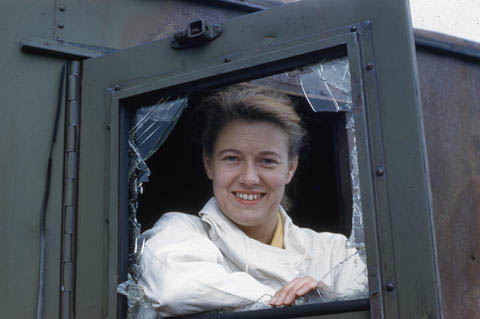Foreword
Barbara Hinds had a deep and abiding interest in the Canadian Arctic even before she arrived in Canada from England in 1956. In 1960, she realized her dream when she and friend, Rosemary Gilliat (later known as Rosemary Gilliat Eaton), took a trip that would influence the rest of their lives. Barbara and Rosemary met in Ottawa at the 1959 meeting of the Canadian Women’s Press Club. The two immediately hit it off and discovered a mutual interest in the Arctic. During the ensuing months, they developed a plan to travel to the eastern Canadian Arctic and document the people, places and circumstances that they encountered. From the outset, the trip was infused with a sense of adventure and risk-taking. Barbara and Rosemary were intent on exploring the Arctic without being limited by any of the usual setbacks reserved for two young female travelers. Their enthusiasm and determination propelled them to an impressive list of places. It was clearly the trip of a lifetime and they embraced all aspects of it, both positive and negative.
After returning to Halifax from the Arctic, Hinds prepared a manuscript for a book about the trip and sent it off to the MacMillan Company of Canada Ltd. On November 30, 1964, MacMillan replied, “We have considered your manuscript, COLLISION IN THE ARCTIC, and I am sorry to report that we are not sufficiently enthusiastic about this work to undertake publication.” Despite her success travelling to far-flung places in the eastern Arctic, this setback proved to be one that she could not overcome. The work lay dormant for the next 54 years.
The digital edition presented here is the first public presentation of Collision in the Arctic as a finished work. The typescript was included in the material donated to the Dalhousie University Archives in 2015 with some of the pages out of order, duplicated and re-written. I have assembled it using my best guess as to how Hinds would have liked it to appear. For those interested in a more complete study of the manuscript, the digitized typescript is available at the Dalhousie University Archives. This digital edition includes the text as was presented in the typescript, with minor typographical corrections and rearrangement. This edition also incorporates audio clips and photographs from the Barabara Hinds fonds. All photographs were taken by Rosemary Gilliat. Many were intended to be part of the book and they provide a meaningful visual accompaniment to the text. A more complete collection of Rosemary Gilliat’s photographs is available from Library and Archives Canada, and her papers and other photographs are available at the Cole Harbour Rural Heritage Society.
Many things have changed since Barbara prepared the original manuscript in 1964. Geographic names have undergone significant revision in the Arctic. Nunavut did not exist in 1960, when the eastern Arctic was included in the Northwest Territories. Important place names in the book such as Fort Chimo (Kuujjuag), Frobisher Bay (Iqaluit), George River (Kangiqsualujjuag) and Port Burwell (Killiniq) have changed to reflect their connection to the indigenous people of the Arctic. Similarly, Hinds uses the term “Eskimo” to refer to the Inuit, which we acknowledge to be a derogatory and offensive label for current readers.
In addition to geographic names, there are also problems with how Hinds spelled some personal names in the text. “Blanket toss under midnight sun: Portraits of everyday life in eight Indigenous communities” (2019) by Paul Seesequasis provides a point of comparison for several individuals who Barbara and Rosemary encountered in Cape Dorset. Based on the work by Paul Seesequasis, I have included updated names of the three print makers shown photographed together in Chapter 23. I have also corrected names for Kenojuak Ashevak and Sheouak Petaulassie (spelled simply as “Kenoyuak” and “Sheouak” in the original typescript for Chapter 23).
For students and scholars interested in the recent history of the Arctic, this book provides a somewhat different perspective from the typical information sources and government documents covering the period. Government programs in the Arctic were administered almost exclusively by men, as were the large-scale construction and resource extraction projects. Even within her own profession, it is clear that Hinds did not identify with the “newsmen” of the period. This detachment is evident when she describes her time with a group of journalists visiting a luxury camp near Cape Dorset in Chapter 22.
With her manuscript, Hinds has provided us with a first-hand account of living and working in the Arctic in 1960. She visited schools, trading posts, co-ops, camps, fish plants and government-sponsored work projects, and provided her perspective on the successes and failures that she observed. Inuit hunters invited Barbara and Rosemary to accompany them on hunting trips and participate in their way of life. Barbara and Rosemary were also invited into people’s homes to hear and record personal stories and tragedies of the people and families living in the Arctic. The result is a fascinating story and an excellent entry point into the Barbara Hinds fonds in the Dalhousie University Archives.

Geoff Brown
Digital Scholarship Librarian
Dalhousie University Libraries

